Empolese Territory

The itinerary unfolds in a territory characterised by water. To the south, the River Arno has for centuries constituted a convenient route to the sea, while to the north, the vast stretch of the Fucecchio Swamp has for centuries supported a thriving economy founded on hunting and fishing. This is the territory that gave birth to the multifarious genius of Leonardo da Vinci.
Empoli, point of departure of the tour, among its museums also boasts a palaeontology collection, housed since the 1980s in the historical headquarters of Palazzo Ghibellino.
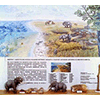
The original core of the Museum's collections derives from the activity of the Geo-palaeontology Group of Empoli. In the late Eighties, in consideration of the large amount of material collected and the lack of suitable facilities for its conservation and use for educational purposes, the Commune of Empoli decided to establish a Civic Museum, located in Palazzo Ghibellino, entrusting its management to the GeA Association.
The Museum contains fossils and rocks which document the history of the Earth. The most consistent core of the collection is made up of fossils coming from Tuscan localities with sedimentation outcrops from the Mesozoic and Caenozoic ages. Of special interest are the malacoid fauna found in the Pliocene deposits emerging in the basins of the Arno, Cecina and Ombrone rivers. The Museum also possesses various models and a life-size diorama displaying a scene of struggle between two dinosaurs.
For schools and organised groups, the GeA Association holds guided tours, educational encounters in areas of geo-palaeontological and naturalist interest (the old Spicchio e Arno Vecchio Quarry) and courses in environmental education, supplemented by practical activities in the laboratory annexed to the Museum.
(Donato Monaco)
After crossing the Arno on SP13, proceed for 11 km until you reach the medieval village of Vinci, the locality where Leonardo was born. The reconstructions of his inventions, carefully based on original drawings, are on show at the Museo Leonardiano.
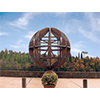
On the occasion of the IV centennial of the death of Leonardo (1919) the idea arose of consecrating to the Vincian genius a museum that would illustrate his work in his native town. Chosen as site of the exhibition was the Castle of the Guidi Counts, donated to the Commune by Count Giulio Masetti da Bagnano. Before the museum opened its doors, however, time passed, because it was inaugurated, after radical restoration that lasted from 1939 to 1942, only in 1952, on the occasion of the V centennial of Leonardo's birth. At this time the exhibition consisted of a number of machines inspired by Leonardo's drawings. In the 1980s the Leonardian Library, housed until then in the Castle, was moved to its present seat, while the museum, in an initiative that was avant-garde for the time, added to the display models made by IBM Italia and presented in a traveling exhibition called "Workshop on Leonardo" before being definitively placed in Vinci. The exhibition proper occupies two different locations: the above-mentioned Castle of the Guidi Counts, whose Sala del Podestà contains a fine Della Robbia Madonna, and Palazzina Uzielli, overlooking Piazza Guidi, where an installation by the artist Mimmo Paladino is found.
It is just from here that the visit commences. In the halls of the Palazzina are displayed textile and construction site machines, whose operation is also illustrated by virtual reconstructions. The exhibition itinerary, designed to exemplify the scientific, theoretical and empirical knowledge of the Renaissance, is well suited to integration with the temporary shows of similar subject held on a regular basis and with the educational workshops conducted here. The halls of the Castle of the Guidi Counts display, instead, models pertinent to the numerous fields of investigation in which Leonardo's tireless spirit of observation was exercised. It is here that visitors can see reconstructions of the futuristic machines designed for flight and for moving water or earth that have so greatly contributed to Leonardo's fame: the "helicopter", the flying machine, the self-propelled cart (or "automobile") and many others. Equally interesting are reproductions of the scientific instruments described by Leonardo in his manuscripts, among them the equalizer, the reflector and the rackwork pinion.
(Alessandro Vezzosi)
A second museum, located 10 metres away and entirely dedicated to promoting knowledge of Leonardo’s multifarious genius, offers an ideal synthesis of the many aspects tied to the study of his cultural legacy.
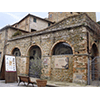
Founded in 1993 through the collaboration of scholars and artist, the Museum was inaugurated under the aegis of the Armand Hammer Center for Leonardo Studies of the University of California at Los Angeles. Conceived as a transposition, both concrete and virtual, of the "Imaginary Museum", it was officially recognised as a Museum of Public Interest in 1999.
It is the first museum to attempt to trace the complex personality of Leonardo in each of its manifold aspects and fields of interest. His activity as artist, scientist, inventor and designer is illustrated with continuous reference to his biography and the places frequented by him. This voyage through the mind and the oeuvre of Leonardo has been made possible by an exhibition that includes all of the reproductions of his pictorial masterpieces, facsimiles of his manuscripts and even a sampling of Leonardo's fingerprints. Unique of its kind is the "Leonardism Archive", the largest existing collection of examples and documentation of the use and abuse of Leonardo's image, from art to the mass media.
The collection also contains originals, including some paintings by members of Leonardo's circle, among the Madonna delle Minime, the Magdalene, the Young Christ at the Age of Twelve, and rare instruments in use in Tuscany in Leonardo's day, such as the "Ritrecine of Leonardo" [horizontal waterwheel]. Bearing witness to Leonardo's fame among his contemporaries are some rare engravings, among them two "Knots" dating from 1505-1507 engraved by Dürer to a design of Leonardo. The display is completed by over 60 models skillfully reconstructed on the basis of his projects, some of them really functioning, such as clocks, fountains, the "painter's house", the theatre of the "Mountain that opens" and other wonders of "Leonardism", including memorabilia and two autograph works by Duchamp.
Recently rearranged, the museum occupies the underground Gallery and the Ancient Wine Cellar of the Castle of the Guidi Counts, whose entrance is at Via Montalbano 2.
Now in the implementation stage is the project "Garden of Leonardo and of Utopia", planned as an outdoor section of the Museum situated in Via Collinare, a few hundred meters from the historic centre of Vinci.
(Alessandro Vezzosi)
A few kilometres outside of town stands the house believed to be the birthplace of the genius from Vinci.
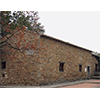
At Anchiano, in the vicinity of Vinci, set in an enchanting landscape, is the house that, with no precise historical proof, is indicated as the place where Leonardo was born on April 15, 1452. Decorated with what has been traditionally considered the stone coat of arms of the "Da Vinci" family, it was restored in 1952, demolishing the non-original exterior and interior additions. A further restoration, carried out in 1986, has attempted to give the exterior its original form of fifteenth-century Tuscan rural house. Inside the house is an iconographic and educational display based on the texts of Leonardo which also includes reproductions of some of his drawings depicting the Tuscan countryside and a map of the Valdarno.
(Graziano Magrini)
Turning back towards Vinci, take SP105 for about 10 km to Cerreto Guidi, a locality dominated by the impressive Medici Villa. Today headquarters of the Museo Storico della Caccia e del Territorio, this building conserves documents relative to Fucecchio Swamp, in addition to a rich collection of weapons.
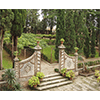
Cosimo I de’ Medici purchased the castle and transformed it into a villa around the mid 16th century on a project attributed to Bernardo Buontalenti. It became the reigning family’s hunting residence and territorial defence in the area. It was donated to the State in 1966. The interior presents several portraits of the Medici family and furnishings from various epochs and origins. A series of maps and relief maps underline its relations with the territory of the Fucecchio marshland.
The Historical Museum of Hunting and the Territory was instituted on the first floor of the villa in September 2002. The exhibits include a weapons collection, mainly for hunting and sports activities, between the 17th and 19th centuries. Also worthy of note is a small collection of eight swamp animals stuffed during the 19th century, and two mechanical clocks from the 17th century, one diurnal, the other nocturnal. The latter has the numbers and fractions of hours bored into it, so that it can be read in transparency thanks to the light of a candle placed inside. The lovely Italian garden situated to the rear of the villa is characterised by the large arbour of a century-old wisteria that covers most of it.
(Graziano Magrini)
The close tie between Fucecchio Swamp and the town of Fucecchio is amply documented by the faunistic exhibits on show in the local museum, which is some ten kilometres further ahead, travelling first Via Piazzale Cerretese and then proceeding westward on SP11.
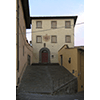
The Museum, reopened in 2004, is situated in historic Palazzo Corsini. Along with sections dedicated to art collections, an archaeological section documenting some aspects of the history of settlements in this area has been set up. Particularly interesting, as regards the natural sciences, is the Lensi Ornithological Collection, formed in the late 19th century and the early 20th by the physician Adolfo Lensi. The collection was conserved by the Lensi family until 1978, the year in which it was acquired by the Communal Administration of Fucecchio, which moved it to the Town Hall. Now occupying the top floor of Palazzo Corsini, it is dedicated mainly to the fauna of the Padule di Fucecchio, and is made up of around 300 specimens. Some of the specimens were stuffed by Lensi himself, while others were prepared by other taxidermists.
(Graziano Magrini)
Finally, man’s centuries-old struggle to regiment the waters of the Swamp is testified in the monumental form of the Medici Bridge of Cappiano, built in the Middle Ages and reconstructed «for public benefit» under Cosimo I de’ Medici.
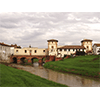
The Medicean Bridge of Cappiano, on the Usciana canal, an emissary of the Padule di Fucecchio (the Fucecchio marshes), played a leading role historically in the system of inland navigation that connected the Bientina Lake, the Padule di Fucecchio, the Arno River and the sea, allowing trade to be carried out in the section between Pistoia and Pisa. This network of waterways was substantially functional up to the time of the nineteenth-century land reclamation projects.
Already in the Middle Ages we find mention of the Cappiano Bridge, managed by the Hospitallers of Altopascio and included in the itinerary of the Via Francigena. In 1325, consequent to a conflict between Florence and Lucca, the bridge was destroyed. It was then rebuilt and fortified with a tower. Subsequently, it became a drawbridge. Leonardo, on folio RLW 12685, indicates and depicts the Cappiano bridge with its defensive structure and, in particular, a tower.
The complex was equipped with a lock to regulate the outflow of the water, and to be used for eel fishing. A water-driven sawmill competed the works.
In the first half of the 16th century Cosimo I de' Medici decided to rebuild the bridge, basically in the form in which we see it today. At that time the covered and the open bridge were built, along with various other buildings: a tavern, an iron-works, a mill and the house of the supervisor who presided over the administration of the farm. This moment is recalled by two stone tablets, one in Latin, the other in Italian:
COSIMO MEDICI DUCA DI FIORENZA
HA RIFATTO QUESTO LOCO DA' FONDAMENTI
PER BENEFIZIO PUBBLICO
ET NON SIA CHI LO DISFACCIA PIU
CON ISPERANZA D'ACQUISTARNE COMMODO AL PAESE
SAPPIENDO OGNI VOLTA CHE S'È DISFATTO
ESSERSI PERDUTO
DI SOTTO L'USO DELLA TERRA
ET DI SOPRA DELLA PESCAGIONE
SENZA ACQUISTO ALCUNO[Cosimo Medici Duke of Florence has rebuilt this place from the foundations for the public benefit and may no one destroy it again in the hopes of helping the town
knowing that whenever it is destroyed the use of the land below is lost
and that of fishing above without benefit of any kind](Graziano Magrini)
****************************
Texts by Elena Fani
English translation by Victor Beard
Last update 19/feb/2008



 = libraries and archives
= libraries and archives  = scientific research centers
= scientific research centers  = memorial places of scientists
= memorial places of scientists = public health places
= public health places = places of science and worship
= places of science and worship = places of technology
= places of technology  = museums and collections
= museums and collections  = villas and gardens of science
= villas and gardens of science



